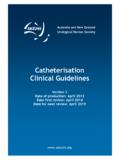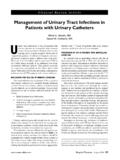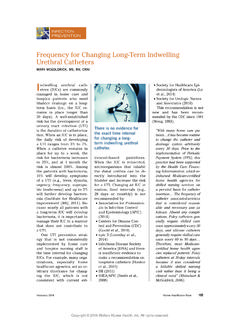Transcription of CATHETER CARE GUIDELINES. - ANZUNS
1 CATHETER care guidelines . The Australian and New Zealand Urological Nurses Society Inc. ( ANZUNS ) is a group of dedicated Urology Nurses, committed to the delivery of best practice. ANZUNS recommendations for the insertion and care of urinary catheters have been developed to support existing organisational guidelines . They are based on current clinical practice Australian and New Zealand wide and where possible supported by published research articles. The information contained in this document is strictly for educational purposes and does not superseed individual institutions policy and procedure guidelines . The authors take no responsibility for any adverse events incurred as a result of using information within this document Responsibility of health care workers To acquire adequate training to carry out the procedure (defined by place of work).
2 Accurate assessment of specific clinical indication for catheterisation. To minimise the trauma and infection risk associated with inserting and maintaining urinary catheters. To minimise psychological trauma to the patient Indications for urinary Catheterisation (but are not limited to). 1. Relieve urinary retention acute/chronic 2. To empty the bladder prior to surgery/investigations 3. To instil medication 4. Determine residual volume in the absence of ultrasound equipment 5. Irrigate the bladder 6. To keep perineal area dry to assist healing 7. Determine accurate fluid balance 8. To collect a sterile specimen of urine. 9. For investigations of the lower urinary tract eg. Urodynamics 10. Management of intractable incontinence 11.
3 Instrumental delivery 12. To allow healing following lower urinary tract surgery 13. Comfort for the terminally ill (Stewart 1998). Initial catheterisation should be in consultation with a medical practitioner. Precautions Undergoing surgery for heart valve replacements or orthopaedic surgery involving joint replacements. Patients with existing heart valve/joint replacements may require antibiotic cover. Distortion of the urethra due to recent urethral/prostate surgery or trauma, urethral strictures. urinary catheterisation is a last resort for long-term continence management, to be used when other management strategies have been exhausted. POSSIBLE COMPLICATIONS. Inability to catheterise Urethral Injury by inflating balloon before insuring correct CATHETER placement in the bladder Infection Psychological Trauma Haemorrhage trauma sustained during insertion or balloon inflation False Passage by injury to the urethral wall during insertion Urethral Strictures following damage to the urethra long term problem Paraphimosis due to failure to return foreskin to normal position following CATHETER insertion.
4 (Blitz 1995). TERM OF CATHETERISATION (Intermittent, Short, Long Term). Catheterisation can be divided into three groups according to the length of time in use. An indwelling CATHETER (IDC), should be left in situ for the minimum possible time. 1. Intermittent: The CATHETER is inserted and removed immediately after emptying the bladder. To relieve acute urinary retention or when medically indicated to obtain a urine specimen, or to check post void residual bladder volume. People who self catheterise should continue to do so if possible during hospitalisation. While in a hospital setting a new CATHETER should be used each time due to an increased risk of infection. (Laker 1995). Self catheterisation is for regular emptying of the bladder.
5 Used mainly in the community to maintain bladder function by complete bladder emptying. As a clean procedure, each CATHETER is usually used for a week. (Laker 1995) The TGA have approved reuse of catheters in the home setting. (CFA conference Nov 2005). Self catheterisation is also used in the management of urethral strictures for dilatation purposes. 2. Short Term Catheterisation . The CATHETER is left in situ for up to one week eg. In a pre-operative and immediate post operative period to monitor urinary output, or if medically indicated. The majority of hospitals represented at the AUNS Catheterisation SIG workshop use latex based silicone coated catheters for short term use except in the instance of latex sensitivity or allergy when 100%silicone catheters should be used 3.
6 Long Term Catheterisation 6 weeks to 3 months Hydrogel coated catheters, or 100% silicone catheters are recommended for long term use. Use 100% Silicone for patients with latex allergy Suprapubic catheterisation may be preferred depending on the individual patient's circumstances (Marsden Manual 2001). Long term catheters should be changed on an individual needs basis and not strictly by time. This can vary dramatically from individual to individual eg if the CATHETER regularly blocks you might anticipate a pattern and change the CATHETER prior. The longest duration a CATHETER should remain indwelling should be based on the manufacturers recommendations for CATHETER usage. There can be significant individual variation in the length of time a CATHETER will remain functional.
7 It is recommended that CATHETER changes are based on: Function of the CATHETER Degree of CATHETER encrustation Frequency of blockage Patient comfort (Ostaszkiewicz 1997). CATHETER SELECTION. Each patient's individual needs should be considered carefully when selecting a CATHETER . These include Indication for catheterisation Consistency of urine Anticipated duration of catheterisation Type of catheterisation ie urethral or suprapubic. ( 2004). CATHETER type Type Indication Straight Nelaton in/out use eg. Intermittent Self Catheterisation A 2 way channel routine drainage A 3 way channel where urine contains clot or debris, or for bladder irrigation A rounded tip routine drainage A whistle tip debris or clot Coude / tieman tip drainage Specialist tips/ Mallecot rarely used.
8 (VUNS 1999). (VUNS 1999). CATHETER materials All catheters used in Australia must conform to the Australian standard AS2696. Polyvinylchloride or Polyurothane Nelaton . for in/out use ie no retaining balloon Latex CATHETER silicone coated used for short term in most institutions these catheters are changed weekly, however the maufacturers quidelines state that they may remaining indwelling for up to 1 month Hydrogel coated changed up to 3 monthly, contains latex. They are well tolerated and are inert. Hydrogel coated catheters become smoother when rehydrated, reducing friction within the urethra. (Nacey and Delahunt 1991). 100%Silicone changed up to 3 monthly, latex free (Marsden Manual 2001). CATHETER Size Choose the smallest CATHETER size that will drain adequately for its intended use Catheters range in size from 5 24 Fg.
9 (Joanna Briggs Institute 2003). General Guide: Women 12 14 Fg Men 16 18Fg Suprapubic 16 20Fg Haematuria 20 -24 Fg If a haematuria CATHETER is required a 3 way should be used to allow for the option of continuous bladder irrigation without requiring a further CATHETER change. When not in use, the irrigating port should be spigotted. CATHETER length Catheters are available in 3 lengths: Paediatric, Regular length and Female length. Female length is a shorter length CATHETER (20-25cm). A shorter length CATHETER may be more convenient for ambulant women with a long term CATHETER . A shorter length CATHETER is not appropriate for all women particularly those who are bedridden or obese. In obese women, the inflation valve of the shorter CATHETER may cause soreness by rubbing against the inside of the thighs, and the CATHETER is more likely to pull on the bladder neck (Britton & Wright 1990; Pomfret 1996).
10 BALLOON SIZE. Use the smallest balloon size possible. This keeps residual urine minimal, reduces the likelihood of bladder spasm, and minimizes damage to the bladder neck from the weight of the balloon. (Joanna Briggs Institute 2003). Balloon sizes: 5 30 mls. The most commonly indicated balloon size is 10ml. Always inflate the balloon to the manufacturers recommended volume indicated on the inflation valve of the CATHETER as well as written on the packaging. The balloon should be fully inflated to the recommended size. Under-inflated balloons may occlude the drainage holes of the CATHETER , or cause distortion of the CATHETER tip, leading to irritation and trauma to the bladder wall (Bard, 1987; Pomfret 1996).
![Index [www.anzuns.org]](/cache/preview/e/5/e/3/7/9/a/a/thumb-e5e379aa8a69f70103ce934b4a1e24f2.jpg)









